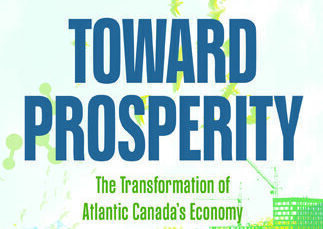Ignoring the Fundamental Issue
Mother, may I go out to swim?
Yes, my darling daughter.
Hang your clothes on a hickory limb
And don’t go near the water.
This anonymous little poem comes to my mind when I read about the advocacy efforts of various anti-sprawl and environmental groups. The obvious absurdity of the poem is that it’s impossible to go out for a swim without going into the water. Therefore, the daughter’s permission to go swimming is rendered meaningless by the imposed condition of keeping away from it.
In the case of environmental groups, their advocacy for the conservation of nature is undermined by their refusal to talk about population growth, when stopping that growth is the only effective way to stop sprawl and preserve nature in the long term.
It is the profiteers of growth who reap the benefits of this self-censorship.
Canada’s falling birthrate and growing population
Canada’s population of nearly 40 million is more than twice what it was in 1975, when its total fertility rate dipped below 2 children per woman and continued on a downward trend to its current 1.4. Despite 50 years of low fertility, Canada’s annual growth rate, hovering around 1%, is the highest among G7 nations. Canada’s rapid growth has been driven by immigration. With balanced migration, where immigration levels approximately match emigration levels, Canada’s population would have stabilized at about 27 million.
The first boost to the hyper migration levels of the last 33 years occurred in 1990 under Brian Mulroney’s Conservative government, when his immigration minister Barbara McDougall raised the annual target to 250,000 annually. This very high level was maintained by every subsequent government. In 2017, Prime Minister Justin Trudeau’s then immigration minister Ahmed Hussen announced that the intake for the ensuing three years would rise annually to 340,000 in 2020. This plan was derailed by Covid, but not for long. In 2022, immigration minister Sean Fraser announced annually increasing targets for the next three years, with 500,000 slated to arrive in 2025.
The primary driver of environmental destruction is off-limits for questioning
The addition in recent decades of approximately ten million people to Canada’s population through immigration have has a significant environmental impact. Most immigrants settle in Canada’s largest cities. For a long time, the Greater Toronto Area (GTA) received approximately half of all of newcomers, and the majority still settle in southwestern Ontario.
This growth has had an enormous impact on the farmland and wildlife habitat of the area. In his 2004-05 Annual Report Planning Our Landscape, released in November, 2005, then Ontario environment commissioner Gord Miller dared to question the necessity of growth and warned of the pressure that future population growth would create on the environment, especially in southern Ontario and the Golden Horseshoe Greenbelt lands where most newcomers settle.
“Even with higher development densities, this is a vast number of people settling in an already stressed landscape. Will the resulting demands for water, sewer systems, roads, utility corridors, aggregates and urban expansion leave our protected countryside and natural heritage systems intact? Will there be enough natural lands to support biodiversity?” (p. 5 of Report)
For this he was savaged by the media at his press conference, where he was accused of being anti-immigrant. “Are you calling for a curtailment to immigration?” one reporter asked. No. “So are you saying that all new immigrants should move to northern Ontario?” No. “Are you saying that the era of the single-family home is over? Are you telling new immigrants they can’t dream of having their own house?”
After some hounding, he told one reporter that immigrants could move to northern Ontario as a solution to the Greater Toronto Area’s overcrowding. This clip was played multiple times on all local news channels. The CBC aired a response by city councillor Maria Augimenti calling for Miller’s resignation. Said Miller, “If people actually read the report, [they’ll find that] the only thing in it about immigration is that it’s another element of population growth and that it’s under federal control. That’s it.”
Tellingly, when asked whether population growth and the resulting economic growth should trump environmental sustainability, the lead inquisitor of Miller’s thrashing, Ian Urquhart, refused to answer. “That’s a good question. I don’t think I’m going to answer it,” Urquhart replied. And he obviously didn’t want anyone else even to be asking it. Then as now, the narrative about Ontario’s vibrant growing communities was not to be disturbed by questions about the biophysical impact of growth. According to the Ontario Farmland Trust, Ontario is currently losing 319 acres of farmland each day.
Despite the obvious connection between population growth and the deterioration of the environment, environmental groups have refrained from suggesting that stabilizing Canada’s population would greatly advance their cause, be it saving farmland, wetlands or forests, preventing development in certain areas, protecting water resources, reducing pollution, or anything else. Perhaps they are silent because they fear getting the Gord Miller treatment. Notably, not a single environmental group spoke up in Miller’s defence following the assault by the media.
Regardless of the reason for their silence, environmental groups are quite content to ignore the inconvenient fact that every city that has grown up has also grown out. Smart growth was being touted as a solution at the time that Miller produced his report, and since then Toronto has sprawled upward and outward. Contrary to the evidence that population growth at the present time is by far the primary driver of sprawl, the mantra remains that “how we grow” is what’s important, not the fact that we keep on growing. The solution to our problems remains “smart growth” and “densification.” All will be well if we just pack ‘em and stack ‘em. It’s those rich people in big houses who are the real problem.
Premier Doug Ford pops the balloon of environmental delusions
Sooner or later, the pretense that continuous simple growth was compatible with conservation was bound to collide with reality. It did so with Premier Doug Ford, elected in 2018, who probably never met a bulldozer he didn’t like. In 2021, Ford shocked environmental groups with Bill 257, “Supporting Broadband and Infrastructure Expansion Act,” which proposed changes to the province’s Planning Act that allowed Minister’s Zoning Orders (MZOs) to override key provisions of that Act and permit development in protected areas outside of the Greenbelt. But more was to come.
As part of what might be called his Paving Over Ontario Project, Premier Ford also wants to expand Ontario’s highway system to accommodate growth. Particularly controversial is the proposed Highway 413, which would form an arc in the northwestern part of the GTA and fell a swath of nature in its path. Next in his line of fire was southwestern Ontario’s Golden Horseshoe Greenbelt, with Ford’s Bill 23, More Homes Built Faster Act, 2022. And, in order to help deal with pesky city councils that sometimes ask awkward questions about proposed developments, Ford tabled Bill-39, Better Municipal Governance Act, 2022, and Strong Mayors, Building Homes Act Regulations, which, among other things, weaken protection of agricultural lands and allow the mayors of Toronto and Ottawa, the province’s two largest cities, to adopt or amend bylaws with only one-third of the vote on their councils.
All of this flurry of legislation is to get 1.5 million homes built in 10 years, a target unlikely to be met. Under Bill 23, the fees developers pay to build new affordable housing developments will be frozen, reduced, or exempted. The Association of Municipalities of Ontario says this could leave municipalities short $5 billion, which would have to be made up by raising taxes. No doubt, current homeowners, many with burdensome mortgages, will be thrilled to help out with the housing costs of their soon-to-be new neighbours.
Doug Ford justified his intention to build on the Greenbelt by saying that the housing crisis had worsened and will become more dire because of immigration. He said he welcomed the federal government’s announcement to bring in 500,000 people annually by 2025, but if hundreds of thousands of additional newcomers a year start arriving in Ontario, there will be no place to house them.
It seems odd that, despite the housing crisis in his province, Ford should celebrate the arrival of hundreds of thousands of newcomers annually. But perhaps he learned his lesson about not questioning the sacred cow of immigration when he was attacked by his political opponents during the election campaign of 2018 for suggesting that Ontario had to “take care of our own” before pushing immigrants to move to northern Ontario. Whatever one may think of his dictatorial methods for dealing with the growth imposed by the federal government (and his refusal to challenge that growth), Ford is right that the 500,000 newcomers who are coming to Canada annually have to live somewhere.
Things have come to a head in Ontario, the destination of the majority of newcomers to Canada. The impact of population growth arising from hyper-immigration is becoming increasingly difficult to mitigate, as wildlife habitat, urban greenspace, and farmland fall to urbanization. One might hope that this grim reality would prod anti-sprawl and environmental groups to recognize the inextricable link between inexorable growth and sprawl, but they remain in a state of denial. The Green Party even accused Ford of “pitting newcomers against the Greenbelt.”
In an editorial of November 22, 2022, The Globe and Mail, Canada’s most widely distributed newspaper, referred to the recent bills passed or proposed by the Ford government as “a shot through the heart of democracy.” Ford and (recently resigned) Toronto mayor John Tory, who supported and even proposed the “strong mayor” legislation, “are not working for the people,” the editorial said. This is the same Globe and Mail that for two years in a row has hosted a webinar by the Century Initiative, which is pushing for a Canadian population of 100 million by 2021. Is that working for the Canadian people?
From silence to Stockholm syndrome?
In Ontario, the narrative that growth without sprawl is possible has just been run over by the physical reality of growth. Premier Doug Ford with his development-promoting bills is the obvious villain, but only those who believe in magic think that what is happening sooner with Ford would not happen later regardless of who was in charge.
Unfortunately, the harsh encounter with reality that Doug Ford with his “open for business” (but not for nature) legislation has inflicted on Ontario has not been enough to shake the self-identified environmental groups out of their Smart Growth stupor.
A newly formed umbrella group consisting of environmental and civic groups and individuals, as well as urban planners, politicians, and policy advisors, calls itself the Alliance for a Liveable Ontario. It states on its home page, as the first point for the future it envisages, that “We welcome a growing population accommodated through government/private sector/non-profit/co-operative/charitable partnerships that build affordable, mixed housing situated within communities that offer a variety of transportation options.” Their remaining four points are a wish list stated as facts. They even call provincial and municipal governments “real partners,” although the former has been passing bills that kick them in the teeth.
Delusions of sustainable forever growth are not limited to Ontario. In a masterpiece of Orwellian dissonance, the City of Edmonton claims we can be “Greener As We Grow.” Grow for how long into the future? Until Canada reaches the population of 100 million that the Century Initiative promotes? In reality, Canada’s growing cities are not becoming greener. Even if Canadians were all densely packed into cities, it would not eliminate their ecological footprint. They would still need food and energy. Even if densely packed, Canada’s growing population undermines its food and resource security.
Some environmental, conservation, and anti-sprawl groups get government funding. No doubt they don’t want to bite any of the hands that feed them. But now it seems that some at least have moved from merely being silent on growth to celebrating it. When supposedly green groups present as a founding principle (“We welcome a growing population…”) the very thing that is destroying what they want to preserve (whether they acknowledge it or not), they are truly captured opposition. They are the green enablers of growth.
The environmentalist dogs may be barking at the growth caravan, but they’re also wagging their tails. The riders on that caravan, the speculators, developers, bankers, and cheap labour businesses, know that they have nothing to worry about.
Does anyone care what Canadians want?
It’s clear that densification is not what Canadians want. Long-term residents of Toronto are leaving the city at a record pace, even as immigrants move in to more than fill the gap. First-time homebuyers, in the words of BMO, are “fleeing to the suburbs.” It seems that being packed like sardines is not the kind of life that Canadians are striving for. Nevertheless, it is the kind of life that allegedly environmental groups like Environmental Defence (perhaps more aptly named Development Defence) are exhorting Canadians to embrace, all while promoting the very growth that is driving them to leave hypertrophying cities.
The more densely a population is packed, the less freedom and time any individual in that population has. People spend more time stuck in traffic, idling at red lights, and waiting for appointments and services. Opportunities to escape the crowd are reduced if nature is an hour’s drive away.
As Canadian cities grow despite the country’s low fertility rate, 15-minute cities are being promoted as a nirvana of sustainability. But could the 15-minute-city ideal that the powers that be are promoting become a dystopian reality? Will freedom of choice about how and where to live be much reduced? Might there be restrictions on travel? Will you have to get permission to leave your allocated region? Will your movements and carbon footprint be tracked and controlled through a non-optional digital currency? So far, the above horrors are the stuff of science fiction (at least in this country), but if we keep prostrating ourselves to the God of Growth they are not unimaginable.
The growth-promoting immigration policies of the government of Canada do not serve the Canadian people. They serve corporate interests that are the profiteers of growth. It is shameful that Canadian environmental organizations have allowed themselves to become the enablers of those policies.
Madeline Weld, Ph.D.
President, Population Institute Canada
Tel: (613) 833-3668
Email: mail@populationinstitutecanada.ca
www.populationinstitutecanada.ca
Editor’s note: This article was originally published on Population Institute Canada’s website (populationinstitutecanada.ca) on February 14th, 2023. It is republished here with permission of the author.
All content on this website is copyrighted, and cannot be republished or reproduced without permission.
Share this article!




The truth does not fear investigation.
You can help support Dominion Review!
Dominion Review is entirely funded by readers. I am proud to publish hard-hitting columns and in-depth journalism with no paywall, no government grants, and no deference to political correctness and prevailing orthodoxies. If you appreciate this publication and want to help it grow and provide novel and dissenting perspectives to more Canadians, consider subscribing on Patreon for $5/month.
- Riley Donovan, editor